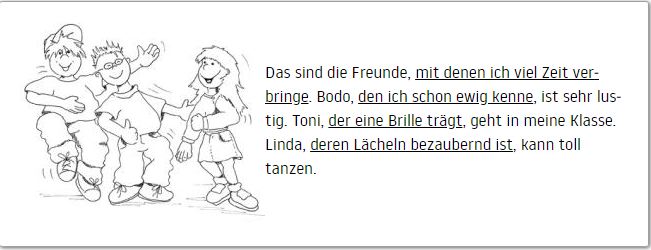Relative Clauses in German Grammar
Construction and Word Oder of Relative Clauses

Relative clauses in German allow us to provide additional information about a noun without starting a new sentence. We can also use them to combine two main clauses. Relative clauses are always introduced by relative pronouns, usually, der, die, das for people and things and not wer/wen (who/whom) as in English relative clauses. In German grammar, relative clauses are always set off by commas.
Relative Clauses in German Grammar
allow us to provide additional information about a noun without starting a new sentence. We can also use them to combine two main clauses. Relative clauses are always introduced by relative pronouns, usually, der, die, das for people and things and not wer/wen (who/whom) as in English relative clauses. In German grammar, relative clauses are always set off by commas.
Example

Usage
We use relative clauses to give additional information about a subject or object, or to turn two main clauses into one complex sentence. The relative clause can be in the nominative, accusative, dative or genitive case.
Nominative: Toni, der eine Brille trägt, geht in meine Klasse.
(Toni trägt eine Brille. – Wer?)
Accusative: Bodo, den ich schon ewig kenne, ist sehr lustig.
(Bodo kenne ich schon ewig. – Wen?)
Dative: Das sind die Freunde, mit denen ich viel Zeit verbringe.
(Mit den Freunden verbringe ich viel Zeit. – Mit wem?)
Genitive: Linda, deren Lächeln bezaubernd ist, kann toll tanzen.
(Lindas Lächeln ist bezaubernd. – Wessen Lächeln?)
Construction and Word Oder of Relative Clauses
To construct relative clauses in German grammar, we use relative pronouns or relative adverbs. They generally come directly after the subject/object to which they refer – this can be at the end of the main clause, or in the middle of the sentence. Relative clauses are dependent clauses so we have to pay attention to the word order and placement of the verb. The verb is always placed at the end of the relative clause.
Declension Table: Relative Pronouns
Relative pronouns change form according to the gender and number of the noun to which they refer. The following table provides an overview of the declension/infelction of relative pronouns in the nominative, accusative, dative and genitive cases.

Which case we use depends on whether the relative pronoun is replacing a subject or an object in the relative clause. Remember that we often have to use a different case in the relative clause than in the main clause.
Example: Bodo, den ich schon ewig kenne, ist sehr lustig.
Bodo ist sehr lustig. (Wer? – nominative in main clause)
Bodo kenne ich schon ewig. (Wen? – accusative in relative clause)
Usage of Relative Pronouns
The relative pronouns der/die/das are generally prefered in everyday speech. Whereas, welcher/welche/welches are mostly used to avoid repeating the same word.
Example: Das ist die Frau, die die Post austrägt.
better: Das ist die Frau, welche die Post austrägt.
A preposition can come before the relative pronoun.
Example: Das sind die Freunde, mit denen ich viel Zeit verbringe.
Relative Adverbs
Relative adverbs do not change form. They often refer to an entire clause rather than a single noun. Some relative adverbs are was, wo, womit, wofür, worüber.
Example: Er spricht fünf Fremdsprachen, was mich sehr beeindruckt.
Ich warte dort, wo wir uns immer treffen.
Christian unterstützte mich, wofür ich ihm sehr dankbar bin.
Sybille besuchte uns, worüber wir uns sehr freuten.
And Then you can improve your German with Learning German App.





























